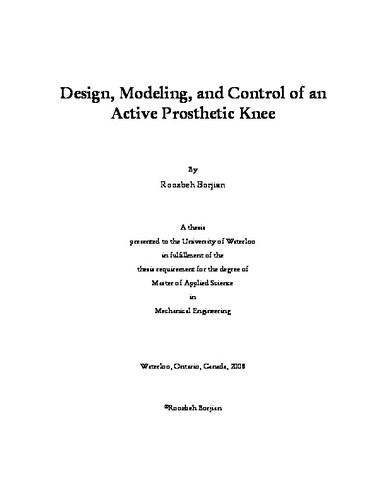| dc.contributor.author | Borjian, Roozbeh | |
| dc.date.accessioned | 2008-10-01 19:37:57 (GMT) | |
| dc.date.available | 2008-10-01 19:37:57 (GMT) | |
| dc.date.issued | 2008-10-01T19:37:57Z | |
| dc.date.submitted | 2008-09-26 | |
| dc.identifier.uri | http://hdl.handle.net/10012/4082 | |
| dc.description.abstract | The few microcontroller based active/semi-active prosthetic knee joints available commercially are extremely expensive and do not consider the uncertainties of inputs sensory information. Progressing in the controller of the current prosthetic devices and creating artificial lower limbs compatible with different users may lead to more effective and low-cost prostheses. This can affect the life style of lots of amputees specially the land-mine victims in developing war-torn countries who are unable to partake in the advancement of the current intelligent prosthetic knees. The purpose of the proposed Active Prosthetic Knee (APK) design is to investigate a new schema that allows the device to provide the full necessary torque at the knee joint based on echoing the state of the intact leg. This study involves the design features of the mechanical aspects, sensing system, communication, and knowledge-based controller to implement a cost-effective APK. The proposed microcontroller based prosthesis utilizes a ball screw system accompanied by a high-speed brushed servomotor to provide one degree of freedom for the fabricated prototype. Moreover, a modular test-bed is manufactured to mimic the lower limb motion which contributes investigating different controllers for the prototype. Thus, the test bed allows assessing the primary performance of the APK before testing on a human subject. Different types of sensing systems (electromyography and lower limb inclination angles) are investigated to extract signals from the user’s healthy leg and send the captured data to the APK controller. The methodology to measure each type of signal is described, and comparison analyses are provided. Wireless communication between the sensory part and actuator is established. A knowledge-based control mechanism is developed that takes advantage of an Adaptive-Network-based Fuzzy Inference System (ANFIS) to determine knee torque as a function of the echoing angular state of the able leg considering the uncertainty of inputs. Therefore, the developed controller can make the APK serviceable for different users. The fuzzy membership function’s parameters and rules define the knowledge-base of the system. This knowledge is based on existing experience and known facts about the walking cycle. | en |
| dc.language.iso | en | en |
| dc.publisher | University of Waterloo | en |
| dc.subject | Prosthetic Knee | en |
| dc.subject | Knowledge-based Controller | en |
| dc.subject | Lower Limb Sensory information | en |
| dc.subject | Wireless Communication | en |
| dc.subject | Echo Control | en |
| dc.subject | Fuzzy Inference System | en |
| dc.subject | Biomechanics | en |
| dc.title | Design, Modeling, and Control of an Active Prosthetic Knee | en |
| dc.type | Master Thesis | en |
| dc.pending | false | en |
| dc.subject.program | Mechanical Engineering | en |
| uws-etd.degree.department | Mechanical and Mechatronics Engineering | en |
| uws-etd.degree | Master of Applied Science | en |
| uws.typeOfResource | Text | en |
| uws.peerReviewStatus | Unreviewed | en |
| uws.scholarLevel | Graduate | en |

